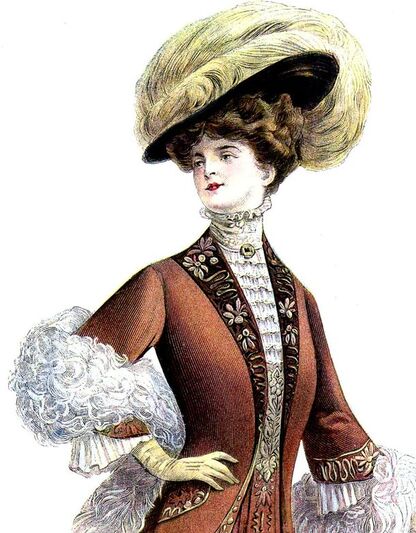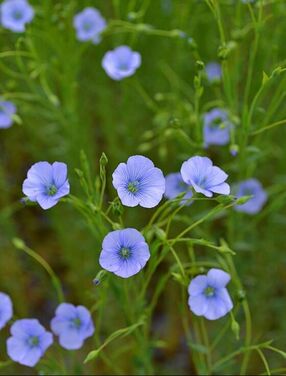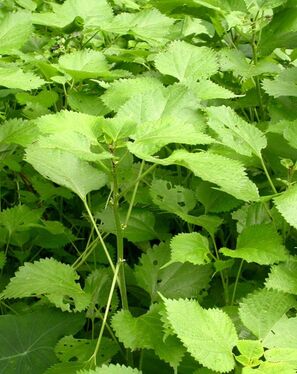|
If one element of women's fashion defined formal daytime elegance during the Edwardian era, it was the high, fitted, boned collar. Unlike their rigid, often plain, Victorian predecessors, the Edwardian boned collar was usually a thing of delicacy and charm, made of fine materials such as lace, chiffon, silk net, or lightweight linen, boned in narrow whalebone, featherbone, or (later) fine zig-zag wires. I've seen all these types in both museum examples and in pieces in my own collection of antique garments, although I have not seen steel bones of any kind used in Edwardian collars. Being able to construct one of these iconic period collars is a key part of creating an ensemble that reflects the time period accurately. I see many sewists struggling with this aspect of historical construction, and am hoping my insight and experience can help! (Please click on "Read More" at right, to see the full tutorial)
1 Comment
This is the first in a planned series of articles intended to help familiarize sewing enthusiasts with the origin, botanical features, history, and production of fabrics available to them, especially considering textiles which may be thought of as having similar characteristics. This Part 1 will look at the two linen "twins": ramie and true flax linen, which are really more fraternal than identical twins. Whether your focus is on historical reproductions or modern sewing, I hope you'll find something useful in these articles to guide your choice of fabrics. What's the difference between true linen (flax) and ramie?Linen textiles come in a diverse and beautiful array of weights, weaves, textures, and colours, for use in everything from fine blouses to upholstery. Yet many people are unaware that a linen-like fabric called ramie exists, or if they do know of ramie, may believe that there is little to distinguish it from true linen made from flax.
Actually, there is quite a difference between these two fibres. Although both are plant-based fibres, the plants from which they come are completely unrelated botanically (see more about this further on). Flax is grown as an annual in northern climates (dies down at the end of the season), whereas ramie is a perennial, grown mostly in humid, tropical or semi-tropical regions. The process required to turn them into cloth is different, and the resulting textiles, although somewhat similar in nature, are in fact quite distinct, with unique characteristics that set them apart. Every so often I have a customer contact me to say they're having difficulty figuring out how to open and/or print a 'History House' pattern at home that they've just downloaded from my Etsy shop. Printing these patterns is usually a matter of just 3 or 4 simple steps once the PDF pattern file has been opened with Adobe. I'm hoping the guidelines below will help with any questions that arise, and will explain some of the principles behind PDF patterns. My main (and first) recommendation to all purchasers of 'History House' PDF patterns is to read the Printing Instructions that come with the pattern download package, and follow them in order, step-by-step. Otherwise, please look through this article to see if any of the advice might help. Getting started with History House PDF patterns:Below is a copy of the Printing Instructions document that comes with every History House PDF pattern. All our patterns are set up to be used with Adobe Reader software (see below). If you're thinking of buying a PDF History House pattern, and you've never tried one before, I recommend looking at these instructions, and then trying the printing process with one of the simple free patterns (see the link just below, or at the very bottom of this article).
A (little) bit of techno-babble:I love what today's technology can do, but I'm definitely not capable of explaining in any detail how it does its magic! I leave that to the geek squad. But here are the basics about History House PDF sewing patterns: (click on "read more", below right, to continue)
Velvet has the reputation – and deservedly so – of being difficult, even terrifying, to work with. It has been a high-status textile for centuries, and was a favourite of the Edwardian era, especially for dressy day gowns, dinner or reception gowns. There is little doubt that a velvet garment can be stunning and beautiful, but some skill and understanding is required to make one that fits and drapes well. My purpose here isn’t to delve into the history of velvet or velvet fashions, but to give you some tips on how to work successfully with this challenging material. First, it's helpful to take a look at the velvets on the market today.
|
AuthorPatricia Preston ('The Fashion Archaeologist'), Linguist, historian, translator, pattern-maker, former museum professional, and lover of all things costume history. Categories
All
Timeline
March 2024
|
||||||






 RSS Feed
RSS Feed